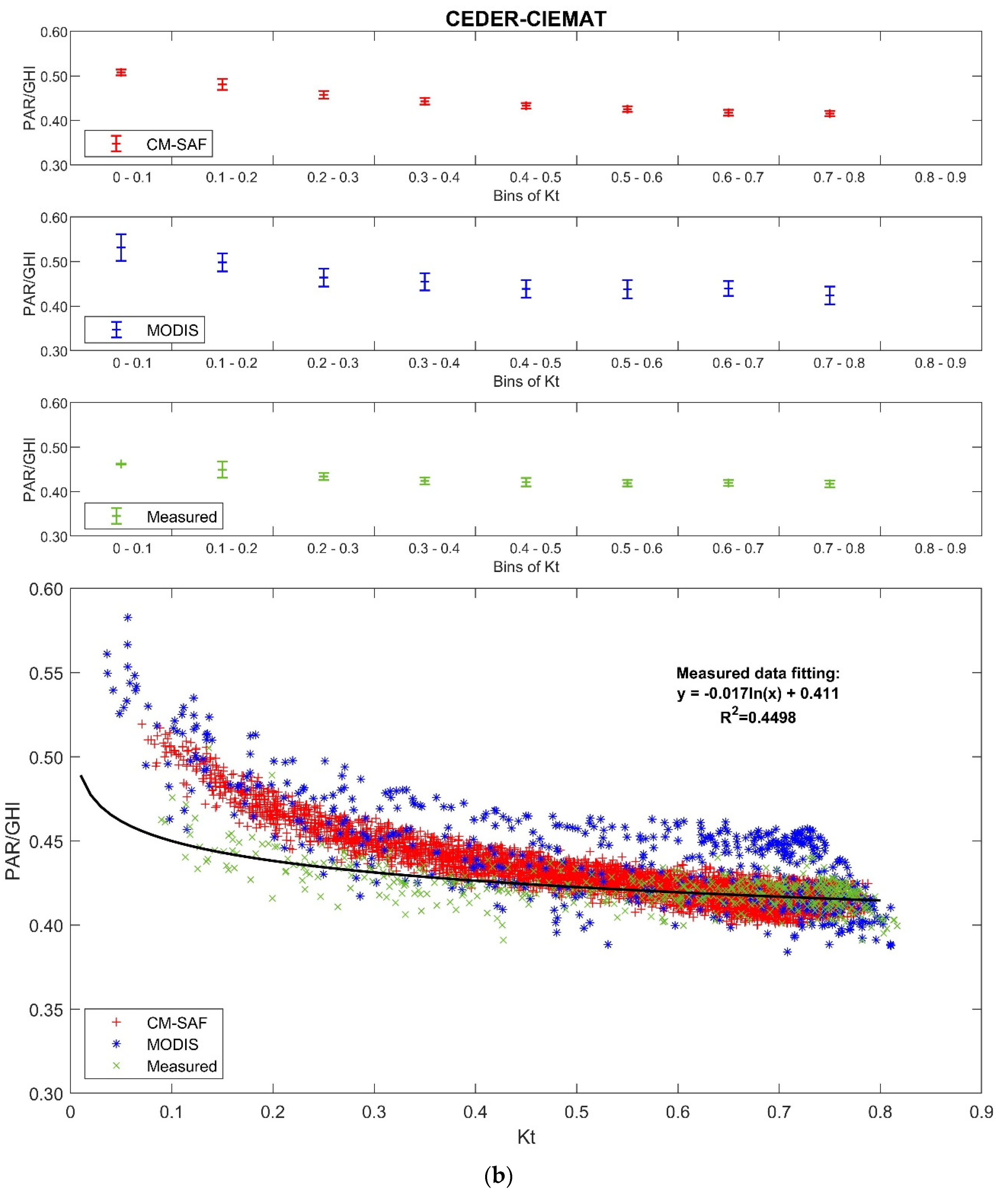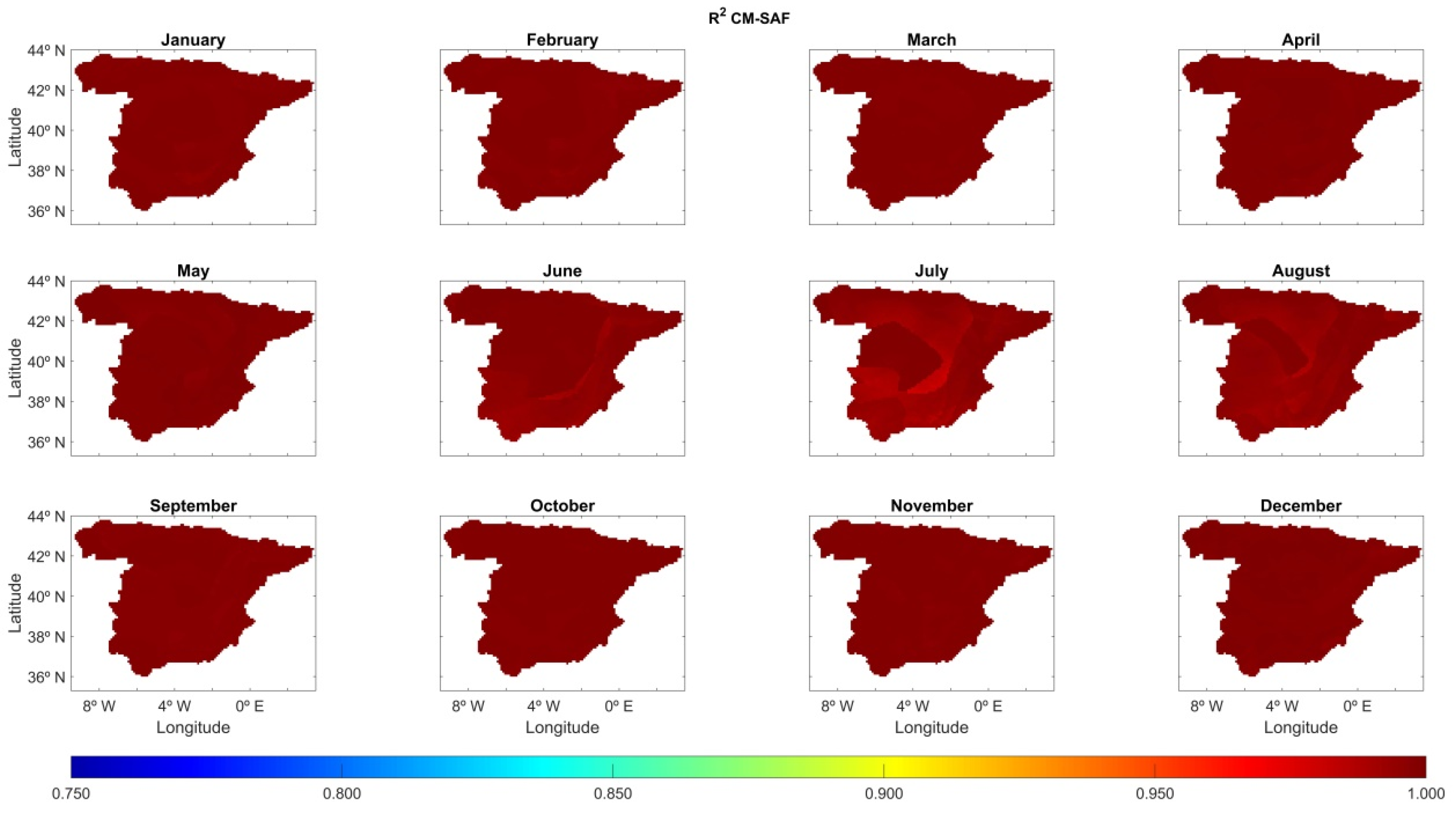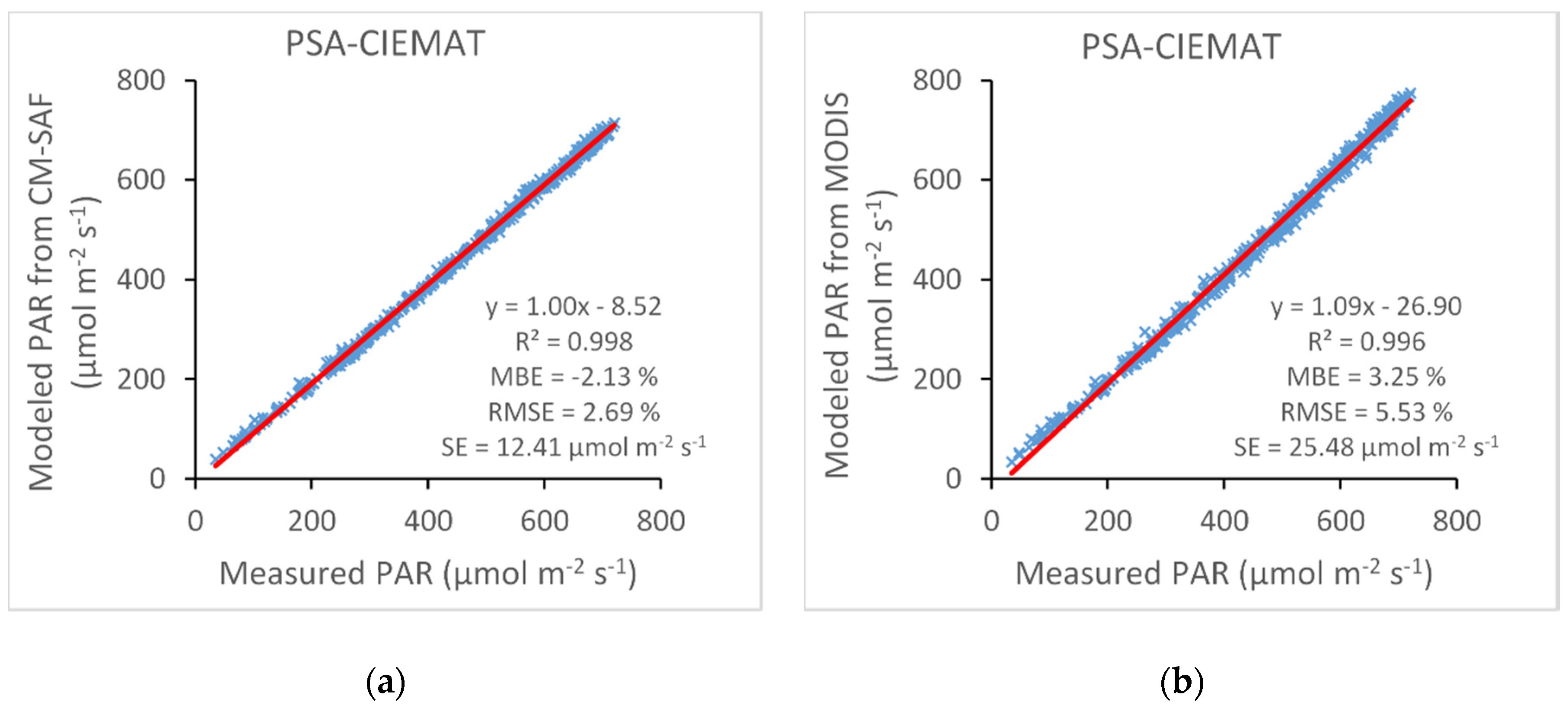Analysis of Spatial and Temporal Variability of the PAR/GHI Ratio and PAR Modeling Based on Two Satellite Estimates
Abstract
:1. Introduction
- The oceanic climate is mainly present in the northern and northwestern parts of mainland Spain. This climate is characterized by mild temperatures and the westerlies (prevailing winds from the west in middle latitudes) that bring frequent clouds and precipitation, with precipitation events quite uniformly distributed throughout the year.
- Mediterranean climates are common in the rest of mainland Spain, including eastern, southern and central areas of the Iberian Peninsula. However, there are no strict boundaries between oceanic and Mediterranean climates, while the transition between them is smooth: the climate gradually shifts as moving toward southern and southeastern Spain. Mediterranean climates have hot summers, and precipitation events are rare, usually as storms. In this climate, two subtypes can be distinguished:
- Standard Mediterranean climate. This subtype is present in southern and eastern mainland Spain, and it is characterized by dry and hot summers and mild winters due to sea influence.
- Continental Mediterranean climate. This subtype is typical in central areas of the Iberian Peninsula. In this subtype, the influence of the sea is weaker and the winters are colder. Thus, seasonal variations are more pronounced than in the Standard Mediterranean climate.
- Analyzing the spatial and temporal variability of the PAR/GHI ratio, considering the main different climatic regions in mainland Spain.
- Comparing PAR/GHI estimates provided by two satellite-derived datasets to determine their best variability.
- Developing PAR estimation models, using GHI as input, and based on each satellite-derived datasets.
2. Data
3. Methodology
- Considering only GHI as input.
- Adding more variables, such as GHI, global extraterrestrial irradiance, relative humidity, and temperature.
- Applying site-adaptation technique (only used for Santiago-EOAS station).
4. Results and Discussion
4.1. Spatial Variability from Ground Measurements
4.2. Temporal Variability
4.3. Performance of the Photosynthetically Active Radiation (PAR) Models
- Considering only GHI as input (model F-C1)
- Adding more variables, such as GHI, global extraterrestrial irradiance, relative humidity, and temperature (model F-C2)
- Applying site-adaptation technique (only used for Santiago-EOAS station) (model F-C3)
5. Conclusions
Author Contributions
Funding
Acknowledgments
Conflicts of Interest
References
- Björkman, O.; Demmig-Adams, B. Regulation of Photosynthetic Light Energy Capture, Conversion, and Dissipation in Leaves of Higher Plants. In Ecophysiology of Photosynthesis; Schulze, E.D., Caldwell, M.M., Eds.; Springer Study Edition; Springer: Berlin/Heidelberg, Germany, 1995; Volume 100. [Google Scholar]
- Wu, C.; Niu, Z.; Tang, Q.; Huang, W.; Rivard, B.; Feng, J. Remote estimation of gross primary production in wheat using chlorophyll-related vegetation indices. Agric. For. Meteorol. 2009, 149, 1015–1021. [Google Scholar] [CrossRef]
- Pinker, R.T.; Zhao, M.; Wang, H.; Wood, E.F. Impact of satellite based PAR on estimates of terrestrial net primary productivity. Int. J. Remote Sens. 2010, 31, 5221–5237. [Google Scholar] [CrossRef]
- Leblon, B.; Guerif, M.; Baret, F. The use of remotely sensed data in estimation of PAR use efficiency and biomass production of flooded rice. Remote Sens. Environ. 1991, 38, 147–158. [Google Scholar] [CrossRef]
- Liang, S.; Zheng, T.; Liu, R.; Fang, H.; Tsay, S.-C.; Running, S. Estimation of incident photosynthetically active radiation from Moderate Resolution Imaging Spectrometer data. J. Geophys. Res. Atmos. 2006, 111, D15208. [Google Scholar] [CrossRef] [Green Version]
- Zheng, T.; Liang, S.; Wang, K. Estimation of incident photosynthetically active radiation from GOES visible imagery. J. Appl. Meteorol. Climatol. 2008, 47, 853–868. [Google Scholar] [CrossRef]
- Nwokolo, S.; Amadi, S. A Global Review of Empirical Models for Estimating Photosynthetically Active Radiation. Trends Renew. Energy 2018, 4, 236–327. [Google Scholar] [CrossRef] [Green Version]
- Wandji, W.; Espinar, B.; Blanc, P.; Wald, L. Estimating the photosynthetically active radiation under clear skies by means of a new approach. Adv. Sci. Res. 2015, 12, 5–10. [Google Scholar] [CrossRef] [Green Version]
- Kato, S.; Ackerman, T.P.; Mather, J.H.; Clothiaux, E.E. The k-distribution method and correlated-k approximation for a shortwave radiative transfer model. J. Quant. Spectrosc. Radiat. Transf. 1999, 62, 109–121. [Google Scholar] [CrossRef]
- Wang, L.; Gong, W.; Ma, Y.; Hu, B.; Zhang, M. Photosynthetically active radiation and its relationship with global solar radiation in Central China. Int. J. Biometeorol. 2014, 58, 1265–1277. [Google Scholar] [CrossRef]
- Akitsu, T.; Kume, A.; Hirose, Y.; Ijima, O.; Nasahara, K.N. On the stability of radiometric ratios of photosynthetically active radiation to global solar radiation in Tsukuba, Japan. Agric. For. Meteorol. 2015, 209, 59–68. [Google Scholar] [CrossRef]
- Wang, L.; Gong, W.; Hu, B.; Zhu, Z. Analysis of photosynthetically active radiation in Northwest China from observation and estimation. Int. J. Biometeorol. 2015, 59, 193–204. [Google Scholar] [CrossRef] [PubMed]
- Iqbal, M. An Introduction to Solar Radiation; Academic Press: Toronto, Japan, 1983. [Google Scholar]
- Xia, X.; Li, Z.; Wang, P.; Chen, H. Estimation of aerosol effects on surface irradiance based on measurements and radiative transfer model simulations in northern China. J. Geophys. Res. Atmos. 2007, 112, D22S10. [Google Scholar] [CrossRef]
- Ångström, A. On the atmospheric transmission of Sun radiation and on dust in the air. Geogr. Ann. 1929, 11, 156–166. [Google Scholar]
- Kidder, Q.; Vonder Haar, T.H. Satellite Meteorology: An Introduction; Academic Press: San Diego, CA, USA, 1995. [Google Scholar]
- McCandless, T.C.; Haupt, S.E.; Young, G.S. A model tree approach to forecasting solar irradiance variability. Sol. Energy 2015, 120, 514–524. [Google Scholar] [CrossRef] [Green Version]
- Hu, B.; Wang, Y.; Liu, G. Spatiotemporal characteristics of photosynthetically active radiation in China. J. Geophys. Res. Atmos. 2007, 112, D14106. [Google Scholar] [CrossRef] [Green Version]
- Alados, I.; Foyo-Moreno, I.; Alados-Arboledas, L. Photosynthetically active radiation: Measurement and modelling. Agric. For. Meteorol. 1996, 78, 121–131. [Google Scholar] [CrossRef]
- Hu, B.; Wang, Y.; Liu, G. Measurements and estimations of photosynthetically active radiation in Beijing. Atmos. Res. 2007, 85, 361–371. [Google Scholar] [CrossRef]
- Escobedo, J.F.; Gomes, E.N.; Oliveira, A.P.; Soares, J. Modeling hourly and daily fractions of UV, PAR and NIR to global solar radiation under various sky conditions at Botucatu, Brazil. Appl. Energy 2008, 86, 299–309. [Google Scholar] [CrossRef]
- Wang, L.; Gong, W.; Li Ch Lin, A.; Hu, B.; Ma, Y. Measurement and estimation of photosynthetically active radiation from 1961 to 2011 in Central China. Appl. Energy 2013, 111, 1010–1017. [Google Scholar] [CrossRef]
- Peng, S.; Du, Q.; Lin, A.; Hu, B.; Xiao, K.; Xi, Y. Observation and estimation of photosynthetically active radiation in Lhasa (Tibetan Plateau). Adv. Space Res. 2015, 55, 1604–1612. [Google Scholar] [CrossRef]
- Yu, X.; Wu, Z.; Jiang, W.; Guo, X. Predicting daily photosynthetically active radiation from global solar radiation in the Contiguous United States. Energy Convers. Manag. 2015, 89, 71–82. [Google Scholar] [CrossRef]
- Aguiar, L.J.G.; Fischer, G.R.; Ladle, R.J.; Malhado, A.C.M.; Justino, F.B.; Aguiar, R.G.; da Costa, J.M.N. Modeling the photosynthetically active radiation in South West Amazonia under all sky conditions. Theor. Appl. Climatol. 2012, 108, 631–640. [Google Scholar] [CrossRef]
- Ren, X.; He, H.; Zhang, L.; Yu, G. Global radiation, photosynthetically active radiation, and the diffuse component dataset of China, 1981–2010. Earth Syst. Sci. Data 2018, 10, 1217–1226. [Google Scholar] [CrossRef] [Green Version]
- Jacovides, C.P.; Boland, J.; Asimakopoulos, D.N.; Kaltsounides, N.A. Comparing diffuse radiation models with one predictor for partitioning incident PAR radiation into its diffuse component in the eastern Mediterranean basin. Renew. Energy 2010, 35, 1820–1827. [Google Scholar] [CrossRef]
- Janjai, S.; Wattan, R.; Sripradit, A. Modeling the ratio of photosynthetically active radiation to broadband global solar radiation using ground and satellite-based data in the tropics. Adv. Space Res. 2015, 56, 2356–2364. [Google Scholar] [CrossRef]
- Mizoguchi, Y.; Yasuda, Y.; Ohtani, Y.; Watanabe, T.; Kominami, Y.; Yamanoi, K. A practical model to estimate photosynthetically active radiation using general meteorological elements in a temperate humid area and comparison among models. Theor. Appl. Climatol. 2014, 115, 583–589. [Google Scholar] [CrossRef]
- Pashiardis, S.; Sa, K.; Pelengaris, A. Characteristics of Photosynthetic Active Radiation (PAR) Through Statistical Analysis at Larnaca, Cyprus. SM J. Biom. Biostat. 2017, 2, 1–16. [Google Scholar]
- Jacovides, C.; Tymvios, F.S.; Boland, J.; Tsitouri, M. Artificial Neural Network models for estimating daily solar global UV, PAR and broadband radiant fluxes in an eastern mediterranean site. Atmos. Res. 2015, 152, 138–145. [Google Scholar] [CrossRef]
- Foyo-Moreno, I.; Alados, I.; Alados-Arboledas, L. A new conventional regression model to estimate hourly photosynthetic photon flux density under all sky conditions. Int. J. Climatol. 2017, 37, 1067–1075. [Google Scholar] [CrossRef] [Green Version]
- López, G.; Rubio, M.A.; Martínez, M.; Batlles, F.J. Estimation of hourly global photosynthetically active radiation using artificial neural network models. Agric. For. Meteorol. 2001, 107, 279–291. [Google Scholar] [CrossRef]
- Van Laake, P.E.; Sanchez-Azofeifa, G.A. Simplified atmospheric radiative transfer modeling for estimating incident PAR using MODIS atmosphere products. Remote Sens. Environ. 2004, 91, 98–113. [Google Scholar] [CrossRef]
- Chen, L.; Gao, Y.; Yang, L.; Liu, Q.; Gu, X.; Tian, G. MODIS-derived daily PAR simulation from cloud-free images and its validation. Sol. Energy 2008, 82, 528–534. [Google Scholar] [CrossRef]
- Janjai, S.; Wattan, R. Development of a model for the estimation of photosynthetically active radiation from geostationary satellite data in a tropical environment. Remote Sens. Environ. 2011, 115, 1680–1693. [Google Scholar] [CrossRef]
- Tripathy, M.; Raman, M.; Chauhan, P. Estimation of photosynthetically available radiation (PAR) from OCEANSAT-I OCM using a simple atmospheric radiative transfer model. Adv. Space Res. 2015, 56, 1441–1452. [Google Scholar] [CrossRef]
- Vindel, J.M.; Valenzuela, R.X.; Navarro, A.A.; Zarzalejo, L.F.; Paz-Gallardo, A.; Souto, J.A.; Méndez-Gómez, R.; Cartelle, D.; Casares, J.J. Modeling Photosynthetically Active Radiation from Satellite-Derived Estimations over Mainland Spain. Remote Sens. 2018, 10, 849. [Google Scholar] [CrossRef] [Green Version]
- Ferrera-Cobos, F.; Vindel, J.M.; Valenzuela, R.X.; González, J.A. Models for estimating daily photosynthetically active radiation in oceanic and mediterranean climates and their improvement by site adaptation techniques. Adv. Space Res. 2020, 65, 1894–1909. [Google Scholar] [CrossRef]
- Wang, D.; Liang, S.; Zhang, Y.; Gao, X.; Brown, M.G.L.; Jia, A. A New Set of MODIS Land Products (MCD18): Downward Shortwave Radiation and Photosynthetically Active Radiation. Remote Sens. 2020, 12, 168. [Google Scholar] [CrossRef] [Green Version]
- Agencia Estatal de Meteorología (AEMET); Instituto de Meteorología de Portugal (IM). Iberian Climate Atlas; AEMET-Ministerio de Medio Ambiente y Medio Rural y Marino & IM: Madrid, Spain, 2011; ISBN 978-84-7837-079-5.
- Linés-Escardó, A. The Climate of the Lberian Peninsula. In Climates of Northern and Western Europe; Elsevier Publishing: Amsterdam, The Netherlands; London, UK; New York, NY, USA, 1970; Volume 5, pp. 195–240. [Google Scholar]
- Capel, J.J. El Clima de la Península Ibérica; Ariel: Barcelona, Spain, 2000. [Google Scholar]
- Bladé, I.; Cacho, I.; Castro-Díez, Y.; Gomis, D.; González-Sampériz, P.; Miguez-Macho, G.; Perez, F.F.; Rodríguez-Fonseca, B.; Rodríguez-Puebla, C.; Sánchez, E.; et al. Climate in Spain: Past, Present and Future. Regional Climate Change Assessment Report of Clivar Spain; Pérez, F.F., Boscolo, R., Eds.; Ministerio de Medio Ambiente y Medio Rural y Marino; Ministerio de Ciencia e Innovación: Madrid, Spain, 2010; ISBN 978-84-614-8115-6.
- Atlas Climático. Available online: http://agroclimap.aemet.es (accessed on 29 January 2020).
- Müller, R.; Pfeifroth, U.; Träger-Chatterjee, C.; Cremer, R.; Trentmann, J.; Hollmann, R. Surface Solar Radiation Data Set-Heliosat (SARAH)-Edition 1; EUMETSAT Satellite Application Facility on Climate Monitoring (CM SAF). 2015. Available online: https://wui.cmsaf.eu/safira/action/viewDoiDetails?acronym=SARAH_V001 (accessed on 11 December 2019). [CrossRef]
- Wang, D. MODIS/Terra+Aqua Surface Radiation Daily/3-Hour L3 Global 5km SIN Grid V006 [Data set]. NASA EOSDIS Land Process. DAAC; 2017. Available online: https://lpdaac.usgs.gov/products/mcd18a1v006 (accessed on 10 November 2019). [CrossRef]
- Wang, D. MODIS/Terra+Aqua Photosynthetically Active Radiation Daily/3-Hour L3 Global 5 km SIN Grid V006 [Data set]. NASA EOSDIS Land Process. DAAC; 2017. Available online: https://lpdaac.usgs.gov/products/mcd18a2v006 (accessed on 10 November 2019). [CrossRef]
- Vindel, J.M.; Valenzuela, R.X.; Navarro, A.A.; Zarzalejo, L.F.; Souto, J.A.; Méndez-Gómez, R.; Cartelle, D.; Casares, J.J. Variabilidad Espacial y Temporal en la Relación PAR/GHI de Acuerdo con el índice de Claridad. In Proceedings of the Libro de Actas del XVI Congreso Ibérico y XII Congreso Iberoamericano de Energía Solar, Madrid, Spain, 20–22 June 2018; pp. 747–752. [Google Scholar]
- Mallet, M.; Dulac, F.; Formenti, P.; Nabat, P.; Sciare, J.; Roberts, G.; Pelon, J.; Ancellet, G.; Tanré, D.; Parol, F.; et al. Overview of the Chemistry-Aerosol Mediterranean Experiment/Aerosol Direct Radiative Forcing on the Mediterranean Climate (ChArMEx/ADRIMED) summer 2013 campaign. Atmos. Chem. Phys. 2016, 16, 455–504. [Google Scholar] [CrossRef] [Green Version]















| Kato Band | Wavelength Region (µm) |
|---|---|
| 7 | 0.408–0.452 |
| 8 | 0.452–0.518 |
| 9 | 0.518–0.540 |
| 10 | 0.540–0.550 |
| 11 | 0.550–0.567 |
| 12 | 0.567–0.605 |
| 13 | 0.605–0.625 |
| 14 | 0.625–0.667 |
| 15 | 0.667–0.684 |
| 16 | 0.684–0.704 |
| Station | Latitude | Longitude | Altitude | Period | Climate |
|---|---|---|---|---|---|
| SANTIAGO-EOAS | 42.88°N | 8.56°W | 255 m a.s.l. | 01/01/2016–31/12/2017 | Oceanic |
| CEDER-CIEMAT | 41.60°N | 2.51°W | 1095 m a.s.l. | 26/01/2016–20/08/2017 | Continental Mediterranean |
| PSA-CIEMAT | 37.10°N | 2.36°W | 500 m a.s.l. | 24/02/2016–22/06/2017 | Standard Mediterranean |
| Station | Owner | Sensor | Model | Manufacturer | Range |
|---|---|---|---|---|---|
| SANTIAGO-EOAS | SANTIAGO-EOAS | PAR | GUV-2511 | Biospherical Instruments Inc. | 305, 313, 320, 340, 380, 395 (nm), and PAR (400–700 nm) |
| MeteoGalicia | GHI | Pyrradiometer 8111 | SCHENK | 300–3000 (nm) | |
| CEDER-CIEMAT | CEDER-CIEMAT | PAR | ML-020P | EKO | 0–3000 |
| CEDER-CIEMAT | GHI | CM21 | Kipp and Zonen | 305–2800 (nm) | |
| PSA-CIEMAT | PSA-CIEMAT | PAR | ML-020P | EKO | 0–3000 |
| PSA-CIEMAT | GHI | CM21 | Kipp and Zonen | 305–2800 (nm) |
| Santiago-EOAS | CEDER-CIEMAT | PSA-CIEMAT | ||||
|---|---|---|---|---|---|---|
| kt | PAR/GHI | kt | PAR/GHI | kt | PAR/GHI | |
| Mean | 0.51 | 45.91 | 0.58 | 42.17 | 0.64 | 43.44 |
| CV | 0.39 | 0.08 | 0.33 | 0.03 | 0.24 | 0.04 |
| Station | Model | Slope | Intercept | R2 | MBE (%) | RMSE (%) |
|---|---|---|---|---|---|---|
| Santiago-EOAS | F-C1 | 0.91 | 9.15 | 0.992 | −6.56 | 9.97 |
| F-C2 | 0.88 | 20.67 | 0.996 | −5.04 | 9.16 | |
| F-C3 | 1.00 | 0.00 | 0.993 | −0.00 | 4.99 | |
| CM-SAF | 0.89 | 15.88 | 0.995 | −6.33 | 9.93 | |
| MODIS | 0.96 | 4.95 | 0.996 | −2.65 | 5.25 | |
| CEDER-CIEMAT | F-C1 | 1.01 | −2.21 | 0.999 | 0.60 | 1.98 |
| F-C2 | 1.00 | 0.41 | 0.999 | 0.29 | 1.86 | |
| CM-SAF | 0.99 | 4.67 | 0.998 | 0.53 | 2.07 | |
| MODIS | 1.08 | −11.10 | 0.997 | 5.28 | 7.32 | |
| PSA-CIEMAT | F-C1 | 1.02 | −16.03 | 0.999 | −1.89 | 2.71 |
| F-C2 | 1.00 | −6.05 | 0.998 | −1.78 | 2.44 | |
| CM-SAF | 1.00 | −8.52 | 0.998 | −2.13 | 2.69 | |
| MODIS | 1.09 | −26.90 | 0.996 | 3.25 | 5.53 |
© 2020 by the authors. Licensee MDPI, Basel, Switzerland. This article is an open access article distributed under the terms and conditions of the Creative Commons Attribution (CC BY) license (http://creativecommons.org/licenses/by/4.0/).
Share and Cite
Ferrera-Cobos, F.; Vindel, J.M.; Valenzuela, R.X.; González, J.A. Analysis of Spatial and Temporal Variability of the PAR/GHI Ratio and PAR Modeling Based on Two Satellite Estimates. Remote Sens. 2020, 12, 1262. https://doi.org/10.3390/rs12081262
Ferrera-Cobos F, Vindel JM, Valenzuela RX, González JA. Analysis of Spatial and Temporal Variability of the PAR/GHI Ratio and PAR Modeling Based on Two Satellite Estimates. Remote Sensing. 2020; 12(8):1262. https://doi.org/10.3390/rs12081262
Chicago/Turabian StyleFerrera-Cobos, Francisco, Jose M. Vindel, Rita X. Valenzuela, and José A. González. 2020. "Analysis of Spatial and Temporal Variability of the PAR/GHI Ratio and PAR Modeling Based on Two Satellite Estimates" Remote Sensing 12, no. 8: 1262. https://doi.org/10.3390/rs12081262





